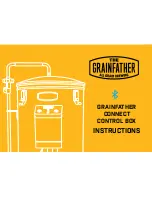
d
e
f
g
h
©
Street
Crane
Co
Ltd
Ref:
D3256
rev.
B
Page
39
of
103
3.17
COMMISSIONING
PROCEDURE
1
Checks
to
be
carried
out
before
switching
on
the
power
supply.
Check
that
the
hoist
installation
is
complete
and
all
fixing
screws
are
secure.
Check
that
the
correct
end
stops
are
in
place.
Check
that
the
electrical
installation
is
complete
and
installed
as
section
3.16.
Ensure
that
the
Earth
continuity
and
insulation
resistance
tests
were
satisfactorily
carried
out.
1
Once
power
supply
is
connected:
‐
Check
that
the
emergency
stop
functions
correctly.
Check
each
motion
by
first
moving
at
SLOW
speed
and
moving
the
minimum
possible
distance
also
ensuring
that
the
direction
of
movements
correspond
to
the
legends
on
the
controller.
Double
girder
–
Travel
the
crab
unit
the
full
length
of
the
crane
to
ensure
that
there
is
sufficient
clearance
between
the
wheel
flanges
and
the
rail.
Single
girder
‐
Travel
hoist
full
length
of
runway
to
ensure
that
adequate
clearance
exists
between
guide
rollers
and
runway.
Check
that
the
clearance
does
not
become
excessive.
Check
that
the
reaction
roller
operates
satisfactorily.
Check
that
the
runway
end
stops
function
correctly.
Set
and
check
the
upper
and
lower
limits
(section
3.6).
Set
the
ultimate
upper
limit
(rotary
type
see
section
3.7,
block
operated
type
see
3.9)
and
the
traverse
limit
(section
3.15)
if
fitted.
Check
and
adjust,
if
necessary,
the
rated
capacity
limiter
(see
section
3.14).
If
the
hoist
is
to
be
subject
to
a
proof
load
test
as
part
of
a
crane
or
runway
installation,
see
the
instructions
for
by
‐
pass
of
the
RCL
in
section
3.14.1.
Run
the
hoist
several
times
under
light
load
(approx
10%
of
SWL)
and
at
slow
speed
to
allow
the
wire
rope
to
bed
down
and
improve
its
service
life.
After
the
running
in
period,
check
that
the
wedge
and
rope
has
seated
correctly
in
the
socket.
Remove
any
twist
imparted
in
the
rope
during
installation,
see
section
5.8.2.6.
The
hoist
is
now
ready
for
proof
load
and
performance
testing
as
required.
Confirm
that
commissioning
has
been
duly
carried
out
and
complete
the
test
logbook
in
section
7.7.
3.18
DISMANTLING
/
REMOVAL
OF
THE
HOIST
The
following
hoist
dismantling
and
removal
procedure
assumes
that
the
hoist
is
still
in
its
original
condition
and
working
in
the
same
environment.
If
the
hoist
has
been
modified
such
that
it
no
longer
resembles
the
original
installation,
the
competent
person
may
decide
on
an
alternative
method
of
removal
and
dismantling.
Raise
the
hook
to
its
upper
level.
Alternatively
the
hook
and
rope
may
be
removed
if
required.
See
5.8.2.1
Electrically
isolate
the
crane,
disconnect
all
electrical
cables.
Remove
any
attachments
such
as
limit
brackets,
cable
towing
arms,
pendant
etc.
Support
the
weight
of
the
hoist
at
its
appropriate
lifting
points.
See
3.3
Double
Girder
Crabs
can
be
lowered
to
the
ground.
For
Foot
Mounted
Hoists
remove
the
foot
bolts
and
check
there
is
no
adhesion
of
the
foot
plates
before
lowering
to
the
ground.
For
4&8
Fall
Low
Head
TVL
Hoists:
‐
Release
the
reaction
roller.
See
3.4.1
Remove
the
locking
grub
screws.
See
3.4
Open
the
low
head
trolley
frame
until
the
wheels
clear
the
runway
flange.
Lower
to
the
floor.
If
the
hoist
is
not
to
be
re
‐
used,
dispose
of
in
an
environmentally
friendly
manner.
Summary of Contents for ZX6
Page 2: ......
Page 4: ...defgh Street Crane Co Ltd IV THIS PAGE IS INTENTIONALLY BLANK ...
Page 99: ...defgh Street Crane Co Ltd Ref D3256 rev B Page 99 of 103 NOTES ...
Page 100: ...defgh Street Crane Co Ltd Page 100 of 103 Ref D3256 rev B NOTES ...
Page 101: ......
Page 102: ......
















































